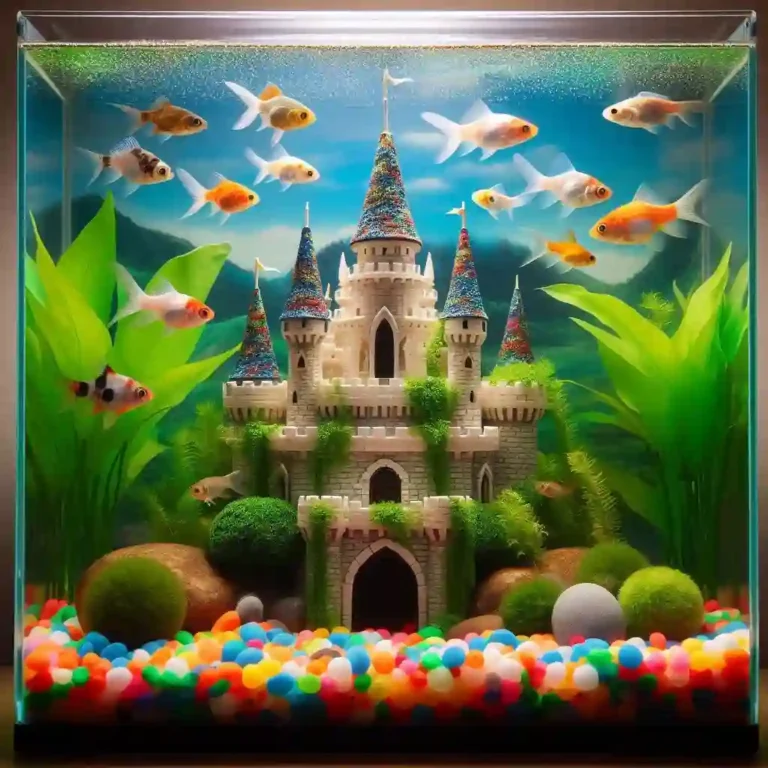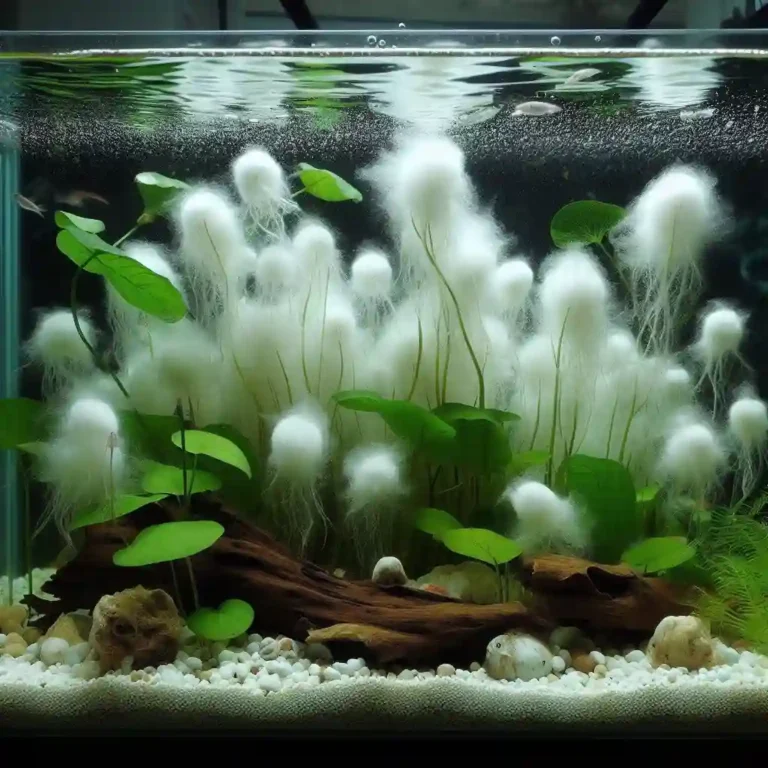10-Gallon Fish Tank Stocking Ideas: A Beginner’s Guide
10-Gallon Fish Tank Stocking Ideas: Setting up a 10-gallon fish tank can be an exciting and rewarding experience, especially for beginners.
With so many species to choose from, it can be overwhelming to decide which fish to stock your tank with. Fear not!
This guide is designed to help you navigate the process of stocking your 10-gallon aquarium with a harmonious and thriving community of fish.
10-Gallon Fish Tank Stocking Ideas: A Quick Guide

Stocking Ideas for a 10-Gallon Tank
- Schooling Fish: Neon Tetras, Harlequin Rasboras, Lemon Tetras
- Peaceful Community: Guppies, Platies, Swordtails, Corydoras Catfish
- Active Swimmers: Zebra Danios, Cherry Barbs, Lemon Tetras
- Bottom Dwellers: Corydoras Catfish, Otocinclus Catfish, Kuhli Loaches
- Surface Swimmers: Hatchetfish, Sparkling Gouramis, Dwarf Gouramis
- Mid-Water Dwellers: Zebra Danios, Cherry Barbs, Lemon Tetras
- Oddballs: Badis Badis, Dwarf Puffers, Threadfin Rainbows
Remember to Research Each Species’ Specific Needs and Ensure Compatibility with the Tank’s Water Parameters
- Avoid Overstocking: 1-2 inches of fish per gallon of water
- Provide Hiding Places: Plants, Decorations, and Rocks
- Maintain Good Water Quality: Regular Water Changes, Monitor Water Parameters
- Feed a Varied Diet: Commercial Flakes, Live/Frozen Foods, and Supplements
Tips for a Successful Stocking
- Start with a Small Number of Fish: 2-3 fish to begin with, then add more as the tank matures
- Monitor Water Parameters: pH, Ammonia, Nitrite, Nitrate, and Temperature
- Provide a Stable Environment: Avoid sudden changes in water temperature, pH, or other parameters
- Be Patient: Allow the tank to mature and the fish to adjust to their new environment
Community Fish: Harmonious Combinations for a Peaceful Tank
Combination 1: The Neon Tetra School
- 10-12 Neon Tetras (Schooling fish that add a splash of color to the tank)
- 3-4 Harlequin Rasboras (Peaceful, small fish that add movement to the mid-water level)
- 1-2 Corydoras Catfish (Bottom-dwelling catfish that clean up food debris)
Combination 2: The Peaceful Community
- 6-8 Zebra Danios (Active, hardy fish that tolerate changes in water conditions)
- 3-4 Dwarf Gouramis (Peaceful, small gouramis that add color and interest)
- 1-2 Otocinclus Catfish (Small, peaceful catfish that clean algae from glass and decorations)
Combination 3: The Small School
- 10-12 White Cloud Mountain Minnows (Schooling fish that add a shimmering effect to the tank)
- 3-4 Lemon Tetras (Small, peaceful fish that add a pop of color)
- 1-2 Honey Gouramis (Peaceful, small gouramis that add interest to the mid-water level)
Small but Mighty: Stocking Ideas for Small Schooling Fish

1. White Cloud Mountain Minnows
- School size: 10-12 individuals
- Water parameters: pH 6.5-8.5, Temp 65-75°F (18-24°C)
- Diet: Omnivorous, eats commercial flake food and small invertebrates
- Notes: Hardy, peaceful, and easy to care for.
2. Lemon Tetras
- School size: 6-8 individuals
- Water parameters: pH 6.5-7.5, Temp 72-82°F (22-28°C)
- Diet: Omnivorous, eats commercial flake food and small invertebrates
- Notes: Active, peaceful, and adds a bright yellow color to the tank.
3. Dwarf Neon Rainbowfish
- School size: 6-8 individuals
- Water parameters: pH 6.5-7.5, Temp 72-82°F (22-28°C)
- Diet: Omnivorous, eats commercial flake food and small invertebrates
- Notes: Peaceful, active, and displays a stunning rainbow color.
4. Sparkling Gouramis
- School size: 6-8 individuals
- Water parameters: pH 6.5-7.5, Temp 72-82°F (22-28°C)
- Diet: Omnivorous, eats commercial flake food and small invertebrates
- Notes: Peaceful, active, and adds a sparkling silver color to the tank.
The Solo Act: Single Species Stocking Ideas for a 10-Gallon Tank
1. Betta Fish
- Ideal for a 10-gallon tank, betta fish are known for their elaborate fins and vibrant colors.
- Water parameters: pH 6.5-8.5, Temp 76-82°F (24-28°C)
- Diet: Carnivorous, eats commercial betta pellets and frozen/live foods
- Notes: Can be kept alone, but requires a heated tank with a lid to prevent jumping.
2. Dwarf Gouramis
- These small, peaceful fish are easy to care for and come in a variety of colors.
- Water parameters: pH 6.5-7.5, Temp 72-82°F (22-28°C)
- Diet: Omnivorous, eats commercial flake food and small invertebrates
- Notes: Can be kept alone, but may fight with other gouramis.
3. Honey Gouramis
- These small, peaceful fish are easy to care for and have a beautiful honey-colored pattern.
- Water parameters: pH 6.5-7.5, Temp 72-82°F (22-28°C)
- Diet: Omnivorous, eats commercial flake food and small invertebrates
- Notes: Can be kept alone, but may fight with other gouramis.
4. Zebra Danios
- These active, hardy fish are easy to care for and can thrive in a 10-gallon tank.
- Water parameters: pH 6.5-8.5, Temp 65-75°F (18-24°C)
- Diet: Omnivorous, eats commercial flake food and small invertebrates
- Notes: Can be kept alone, but may be more active with tankmates.
The Bottom Dwellers: Stocking Ideas for Catfish and Loaches

1. Corydoras Catfish
- School size: 6-10 individuals
- Water parameters: pH 6.5-8.5, Temp 72-82°F (22-28°C)
- Diet: Omnivorous, eats commercial flake food and small invertebrates
- Notes: Peaceful, small, and great for cleaning up food debris.
2. Otocinclus Catfish
- School size: 6-10 individuals
- Water parameters: pH 6.5-7.5, Temp 72-82°F (22-28°C)
- Diet: Herbivorous, eats algae and commercial flake food
- Notes: Peaceful, small, and great for cleaning algae from glass and decorations.
3. Kuhli Loaches
- School size: 3-5 individuals
- Water parameters: pH 6.5-7.5, Temp 72-82°F (22-28°C)
- Diet: Omnivorous, eats commercial flake food and small invertebrates
- Notes: Peaceful, nocturnal, and great for adding interest to the bottom of the tank.
4. Zebra Loaches
- School size: 3-5 individuals
- Water parameters: pH 6.5-7.5, Temp 72-82°F (22-28°C)
- Diet: Omnivorous, eats commercial flake food and small invertebrates
- Notes: Peaceful, active, and great for adding movement to the bottom of the tank.
When stocking catfish and loaches, remember to:
- Research each species’ specific needs and ensure compatibility with the tank’s water parameters.
- Provide plenty of hiding places and visual barriers to reduce stress.
- Feed a varied diet that meets the species’ specific dietary needs.
- Avoid overstocking, as bottom dwellers can quickly overpopulate a tank.
The Top Dwellers: Surface-Swimming Fish for a 10-Gallon Tank
1. Hatchetfish
- School size: 6-10 individuals
- Water parameters: pH 6.5-8.5, Temp 72-82°F (22-28°C)
- Diet: Omnivorous, eats commercial flake food and small invertebrates
- Notes: Peaceful, active, and great for adding movement to the surface.
2. Sparkling Gouramis
- School size: 3-5 individuals
- Water parameters: pH 6.5-7.5, Temp 72-82°F (22-28°C)
- Diet: Omnivorous, eats commercial flake food and small invertebrates
- Notes: Peaceful, active, and great for adding a sparkling effect to the surface.
3. Dwarf Gouramis
- School size: 3-5 individuals
- Water parameters: pH 6.5-7.5, Temp 72-82°F (22-28°C)
- Diet: Omnivorous, eats commercial flake food and small invertebrates
- Notes: Peaceful, active, and great for adding color and interest to the surface.
4. Pygmy Halfbeaks
- School size: 6-10 individuals
- Water parameters: pH 6.5-8.5, Temp 72-82°F (22-28°C)
- Diet: Omnivorous, eats commercial flake food and small invertebrates
- Notes: Peaceful, active, and great for adding movement and color to the surface.
The Mid-Water Dwellers: Stocking Ideas for Active Swimmers
1. Zebra Danios
- School size: 6-10 individuals
- Water parameters: pH 6.5-8.5, Temp 65-75°F (18-24°C)
- Diet: Omnivorous, eats commercial flake food and small invertebrates
- Notes: Active, hardy, and great for adding movement to the mid-water level.
2. Cherry Barbs
- School size: 6-10 individuals
- Water parameters: pH 6.5-7.5, Temp 72-82°F (22-28°C)
- Diet: Omnivorous, eats commercial flake food and small invertebrates
- Notes: Peaceful, active, and great for adding color and interest to the mid-water level.
3. Lemon Tetras
- School size: 6-10 individuals
- Water parameters: pH 6.5-7.5, Temp 72-82°F (22-28°C)
- Diet: Omnivorous, eats commercial flake food and small invertebrates
- Notes: Active, peaceful, and great for adding a bright yellow color to the mid-water level.
4. Platies
- School size: 6-10 individuals
- Water parameters: pH 6.5-8.5, Temp 72-82°F (22-28°C)
- Diet: Omnivorous, eats commercial flake food and small invertebrates
- Notes: Peaceful, active, and great for adding color and interest to the mid-water level.
The Oddballs: Unique and Unconventional Stocking Ideas
1. Badis Badis
- School size: 3-5 individuals
- Water parameters: pH 6.5-7.5, Temp 72-82°F (22-28°C)
- Diet: Carnivorous, eats small invertebrates and commercial pellets
- Notes: Peaceful, unique, and great for adding interest to the mid-water level.
2. Dwarf Puffers
- School size: 3-5 individuals
- Water parameters: pH 6.5-7.5, Temp 72-82°F (22-28°C)
- Diet: Carnivorous, eats small invertebrates and commercial pellets
- Notes: Peaceful, unique, and great for adding interest to the mid-water level.
3. Threadfin Rainbows
- School size: 6-10 individuals
- Water parameters: pH 6.5-7.5, Temp 72-82°F (22-28°C)
- Diet: Omnivorous, eats commercial flake food and small invertebrates
- Notes: Peaceful, active, and great for adding color and interest to the mid-water level.
4. Pygmy Sunfish
- School size: 3-5 individuals
- Water parameters: pH 6.5-7.5, Temp 72-82°F (22-28°C)
- Diet: Omnivorous, eats commercial flake food and small invertebrates
- Notes: Peaceful, unique, and great for adding interest to the mid-water level.
The Cycling Process: How to Introduce Fish to Your 10-Gallon Tank
How Long Does the Cycling Process Take?
The cycling process typically takes 2-4 weeks, depending on factors like tank size, water temperature, and the type of filter media used.
How to Introduce Fish to Your 10-Gallon Tank
- Wait for the Cycling Process to Complete: Before introducing fish, make sure the cycling process is complete. You can check for this by monitoring ammonia and nitrite levels.
- Choose Hardy Fish: Select hardy fish that can tolerate minor water quality fluctuations, such as zebra danios or cherry barbs.
- Introduce Fish Gradually: Introduce fish in small groups, allowing the tank to adjust to the bioload.
- Monitor Water Parameters: Regularly monitor water parameters, such as ammonia, nitrite, and nitrate levels, to ensure the tank is stable.
- Provide Hiding Places: Provide plenty of hiding places, such as plants or decorations, to reduce stress on your fish.
Tips for a Successful Fish Introduction
- Avoid overstocking your tank, as this can lead to water quality issues.
- Feed your fish lightly, as excess food can contribute to water quality problems.
- Perform regular water changes (10-15% every week) to maintain water quality.
FAQs
Q: How many fish can I keep in a 10-gallon tank?
A: The number of fish you can keep in a 10-gallon tank depends on the size and type of fish. A general rule of thumb is to keep 1-2 inches of fish per gallon of water. For a 10-gallon tank, you can keep 10-20 inches of fish.
Q: What are some good fish for a 10-gallon tank?
A: Some good fish for a 10-gallon tank include neon tetras, guppies, harlequin rasboras, and zebra danios. These fish are small, peaceful, and easy to care for.
Q: How do I choose the right fish for my 10-gallon tank?
A: When choosing fish for your 10-gallon tank, consider the following factors:
- The size and type of fish
- The water parameters of your tank (pH, temperature, etc.)
- The compatibility of the fish with each other
- The level of maintenance required for the fish
Q: How do I cycle my 10-gallon tank?
A: Cycling your tank involves allowing beneficial bacteria to establish themselves in the tank. This process typically takes 2-4 weeks. You can speed up the process by adding a commercial bacteria supplement.
Q: How often should I clean my 10-gallon tank?
A: It’s a good idea to clean your 10-gallon tank regularly to keep the water quality high and the fish healthy. You can clean the tank by vacuuming the gravel, cleaning the glass walls, and replacing 10-15% of the tank water.
Q: What are some common mistakes to avoid when stocking a 10-gallon tank?
A: Some common mistakes to avoid when stocking a 10-gallon tank include:
- Overstocking the tank with too many fish
- Not providing enough hiding places for the fish
- Not maintaining good water quality
- Not providing a varied diet for the fish

Hello, I’m Aria Cooper, the heart and soul behind Swimmy Buddies. As a devoted fish aficionado, I share my aquatic adventures and expertise to inspire your own underwater explorations. 🐠🌊







